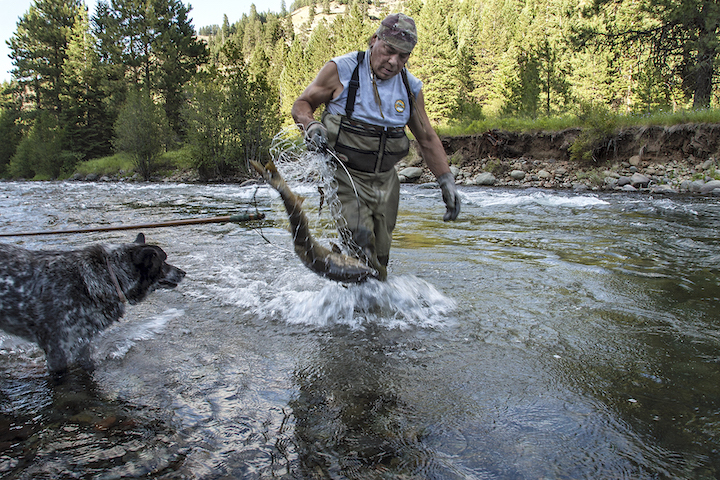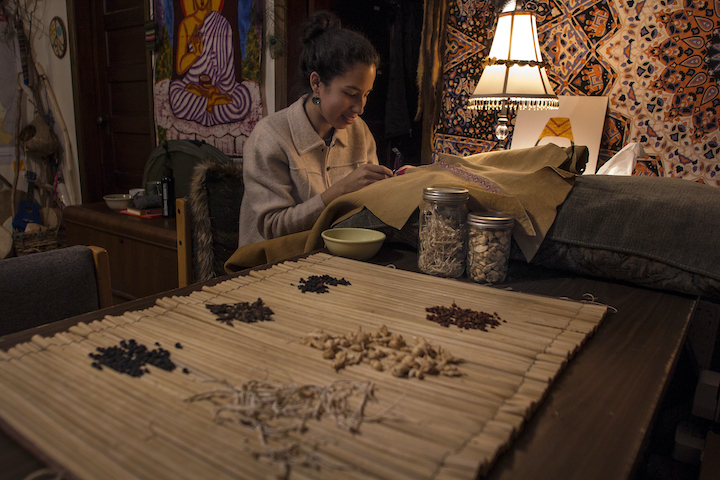Throughout human memory, the Indigenous peoples of the Columbia Plateau have adhered to a physical and spiritual philosophy of reciprocal, equitable, and equal relationships between human beings and with the natural world around them. Times of abundance and times of hardship are shared by their communities as a whole. Community members are expected to contribute according to their roles, skills, and abilities, and protocols exist to ensure care for Elders, children, the sick or disabled, and the needy. This philosophy, called Tamanwit by people of the Columbia River watershed like the Yakama, Walla Walla, Umatilla, and Cayuse, and Tamalwit by the Nimiipuu (Nez Perce) living farther up the Columbia, Clearwater, and Snake River watersheds, is also known as the unwritten or original law. Tamanwit provides for a sustainable relationship with the natural world as well as a sustainable human society.
Yakama tribal Elder Wilson Begay, who is from the village at the former site of Celilo Falls on the Columbia River, once told me, “The Big River Council of fish chiefs from the different bands used to meet and talk about livelihood and who they needed to help that year. Who needed help with extra food, or fixing up a fishing site. It wasn’t about controlling, it was just about general life, to help each other and look after each other.”
The reciprocity woven into Tamanwit allowed tribes of the plateau to thrive in their homelands for millennia. It includes rules of conduct such as “Never take more than you need” and “Always leave something for those who come behind.”
After the arrival of imperial colonialism—a way of life that commodifies human and ecological relationships rather than embracing them as reciprocal gifts of sustainable existence—the ecological and social safety nets maintained by Tamanwit began to unravel. Despite colonialist efforts to erase their culture and traditions, Indigenous communities are still embracing those sacred gifts and Ways to help strengthen and repair their union with each other and with the land.

The drawings and words in the photo above were etched on the brick walls of a solitary confinement cell at Fort Spokane by Indigenous children as young as six years old. In an attempt to assimilate these children into white society and erase their cultural identity, the US government operated an Indian boarding school at the fort from 1900 to 1914. If children tried to escape to return to their families, or otherwise “acted out” by practicing their cultural traditions or speaking their language, they could be imprisoned in solitary confinement or receive harsh physical abuse (which in many Indian boarding schools included sexual abuse). Fort Spokane took children by force from the Spokane Indian Reservation and the Confederated Tribes of the Colville Reservation in northeast Washington. Chief Joseph and the Wallowa Band of Nez Perce (who are from what is now northeast Oregon) were exiled to the Colville Reservation as punishment for resisting forced relocation during the infamous Nez Perce War of 1877. Forced removals, confinement to reservations, loss of access to subsistence resources, and a litany of forced assimilation policies that lasted well into modern times all served to traumatize Indigenous people and harm significant parts of their identity and well-being. Traumatized children grow into traumatized adults, who unintentionally, and even by genetic code, pass that trauma on to their children. Cycles of harm began to replace ancient cycles of community health and opportunity.

Ecological systems that are interwoven with Indigenous lifeways and identities endured the same trauma and harm that Indigenous people experienced. The Grand Coulee Dam, pictured above , flooded tribal villages and severed the passage of salmon and steelhead to the upper Columbia River and the many tribes who depended on them. Other dams caused similar harm throughout the Pacific Northwest. Chief Joseph once said, “The earth and myself are of one mind. The measure of the land and the measure of our bodies are the same.” Each unique aspect of a homeland ecology is like a personality trait or a physical limb of the people themselves. When those ecologies are harmed, it is experienced as personal harm by Indigenous people. The physical harm can be very literal and direct, such as the loss of primary food sources like salmon and buffalo, or the rise of diseases caused by pollution from extractive industries placed near Indigenous communities.
The loss of cultural identity also harms Indigenous people. A recent study published in the International Journal of Intercultural Relations shows a correlation between the health and well-being of Indigenous people and their connection to traditional cultures through land, kinship, and knowledge. Indigenous children whose parents promote a strong sense of cultural identity in early childhood experience better health and socio-emotional outcomes later in life. The findings suggest that a strong cultural identity acts as a protective barrier to many of the challenges faced by Indigenous people.

In the photo above, Levi Carson, a Nez Perce Tribal Fisheries worker, uses a dip net to catch a Chinook salmon from the upper Imnaha River in the Wallowa Band’s homelands. Levi’s family has caught fish from this river in this way for over fifteen thousand years. That sustenance not only provides food for his family, but also helps to keep their traditions and cultural identity alive. The Nez Perce Tribe has invested resources in restoring the ecology of the waters in their homelands, giving jobs to people like Levi and helping the community access traditional food sources, called First Foods by local tribes.
When a community acts as a whole to prioritize lifeways such as Tamalwit, the benefits cascade throughout that community. Those benefits are particularly necessary today for Native communities struggling to recover from the gaps in opportunity that were forced upon them. According to the 2016 American Community Survey, more Native American children live in poverty in the United States than children of any other race or ethnicity—and they are nearly three times as likely as white children to experience poverty. Native Americans develop diabetes at a rate 189 percent higher than the national average, due in part to loss of access to traditional food sources. Native Americans’ likelihood of experiencing violence is more than twice the national average, and over 90 percent of Native men and women have been victims of interracial violence. Native Americans are the racial or ethnic group most likely to experience police violence.

In the photo above, Kanim Moses-Conner, a tribal member from the Confederated Tribes of the Umatilla Indian Reservation in Eastern Oregon (CTUIR), handles lamprey eels as part of the CTUIR tribal fisheries program. Nearly eliminated by eradication programs, lamprey were once regarded as a “pest fish” by the state of Oregon. But they’ve been a food source for the Plateau Tribes and other native species of the region since time immemorial, and are now understood to serve a vital role in river ecologies. The tribes of the Columbia River watershed have used the sovereign treaty rights they possess to force legal actions that protect ecological interests, such as the construction of fish passageways in many of the region’s dams. The Treaty of 1855, which tribes like the Nez Perce and the Cayuse, Walla Walla, and Umatilla (CTUIR) signed, promises that the tribes shall retain access to all of their original food sources on all federal land and jurisdiction within their homelands. This set a legal standard that forces the federal government to take action to preserve those so-called natural resources where it has the authority to do so.
Tribes have continued to use their treaty rights and ecological protocols to work with other conservation organizations and agencies to aid in the recovery of all threatened species native to their homelands, and to revive subsistence practices that were damaged by environmental destruction and forced assimilation policies. In recent years, 1855 Treaty tribes from the Columbia Plateau have reestablished their seasonal practice of traveling over the Continental Divide to hunt wild American bison near Yellowstone National Park.
“Before the treaty, [hunting and gathering] was our normal way of life, so we try to normalize it as much as possible,” says Kanim Moses-Conner. “Like my dad says when we go to hunt, ‘Ready to go get some groceries?’ Because that’s how we got our ‘groceries’ before colonialism. Everything I do, from gathering medicines to fishing, berry-picking, and hunting, is to connect with the land. With hunting, hiking, fishing, gathering, etc., you revisit places your family has been visiting for thousands of years. It’s important we keep visiting them to provide for our families.”
The hunts are strictly managed by tribal conservation officers and guided by tribal protocols and expectations. All parts of the animal but the guts must be removed and used. Significant amounts of the meat must be given away to those in need. Hunters don’t hunt just for themselves, but to feed their community and to provide for cultural events, which often involve community feasts and gift-giving ceremonies. Those traditions remind people of the reciprocity required by the unwritten laws. Nick Eastwood, a Cayuse bison hunter, says, “Every living thing is our relation, and we must take care of one another to survive. Our mother, the earth, provides us with everything we need. In turn, we must take care of her and treat her with respect. When we partake in traditional practices, whether religious, food harvesting, or anything else, we are connecting with our ancestors.”

Above, Kanim Moses-Conner enjoys the Wallowa Mountains alongside Doug Marconi, a member of the Wallowa Band Nez Perce from the Colville Reservation, and the author’s daughter, River, an enrolled tribal member of the Caddo Nation of Oklahoma. Moses-Conner’s and Marconi’s families have hiked this wild landscape since the last ice age finished sculpting it. Hiking, backpacking, climbing, skiing, snowshoeing, rafting, and other outdoor activities, while beneficial for everyone, offer an added sense of intense fulfillment and cultural connection for Indigenous people in their homelands. “Anywhere I walk in these mountains, I feel like I am walking where my ancestors have before me,” Moses-Conner says. Found within Oregon’s largest wilderness area, the Eagle Cap Wilderness, the Wallowa Mountains are called Walwamox by their people. The snow on the peak behind them is the remnant of the last glacier in the Walwamox, now classified as a “permanent snowfield.” The very same ice connecting that snowfield to the mountainside today has provided watershed sustenance to their families for over fifteen thousand years. It is truly a physical and spiritual medicine for their identities and well-being.
Many young Indigenous families today are working to ensure that their children and the following generations have the opportunity to embrace all of the sustaining gifts inherent to Ways such as Tamanwit. Meadow, an eight-year-old whose family is from the CTUIR, says, “The best thing is just being able to be in my homelands, and being able to still have those teachings. I want to carry those things on for a good seven generations if I can.” In the photo below, Meadow and her mother, Brosnan, prepare to strip limbs from a freshly harvested pit-lodge pole. Meadow’s father, Bobby, is Walla Walla and Yakama, and Brosnan is Cayuse, Umatilla, and Seminole. Bobby and Brosnan have dedicated themselves to living as much from the First Foods and practices of their Tamanwit way of life as possible, and are working to restore damaged ecosystems and relationships that have been harmed in their homelands.

“Meadow is being witnessed by the land,” Brosnan says. “She is learning her place in the ecosystem. As she gathers roots and berries for the year or helps build a traditional lodge, she is strengthening her connection to the land, all along the way regaining her birthright of Indigenous sovereignty with the land and waters of this region of her homelands. Rather than being locked into dependence on a colonial system that causes harm to the land, water, and air, living in symbiosis with the land and learning the interconnectedness of it all bring a sense of belonging. She will always have that relationship to tend.”
Brosnan offers instructional services in making medicine and tule-reed mats to tribal members of the CTUIR and other Indigenous people in the region. “I bring samples of the roots and berries I dry every year with me,” she says. “The tule mats are drying racks, the food is laid out to dry on them. In the longhouse, when we bring the foods in from gathering, we lay out the bags of roots, berries, and meat to welcome them in. It was our table in the past. I speak about how tule mats were used in the past, how they are still being used today, and when to gather. I am also going to be teaching my first hide-tanning class soon.”
Bobby oversees the restoration of eighty acres of land owned by the local Episcopal diocese, which has committed to restoring the property to a proper functioning riparian habitat and First Food forest and garden as a means to reconcile with the original peoples and ecosystems of the land. He also oversees sovereignty camps and workshops hosted on the property. Camas, tule, willows, cottonwoods, alders, red osier dogwood, water birch, serviceberry, currants, chokecherries, blackcap raspberries, plums, bunchgrasses, various lomatiums, native sunflowers, hemp dogbane, and showy milkweed now grow there. Braided stream channels and wetlands on the property are being restored to encourage fish and other aquatic organisms as well as waterfowl and upland game. Bobby and Brosnan also manage 160 acres of homestead land, which a local resident is leaving to Meadow as an inheritance, to rebuild access to Indigenous lifeways for their people. They are selectively thinning and burning the forest to encourage serviceberries and huckleberries and to build resilience to high-intensity summer wildfires. They’ve also begun construction of a traditional pit lodge.

In the photo above, Brosnan stitches beadwork onto a buckskin dress she tanned herself for Meadow’s traditional regalia. On the tule mat next to her are representations of preserved First Foods. Brosnan says the serving order on the mats at their longhouse feasts matches the order in which each food arrives in its natural cycle throughout the year. This reminds them of the reciprocity of Tamanwit. “I feel like I’m really remembering who I am and my place in the world when I’m out with the Foods,” she says. “I can just settle, and not have the rat race, you know? I’m just focused on the roots; there’s just one thing to focus on. I’m with my daughter most of the time, and we’re out there for hours. It’s meditation motion. That’s where I can really settle my mind and connect with my heart—which tells me I’m a part of this. And it makes sense. And being out there every season, that relationship grows deeper and deeper every year. That has really filled a lot of gaps for me, like who I am, and why I’m here. And when we gather, we are gathering in such a way that also gives something back. When I’m bringing my cuppin [digging tool] into the soil, I’m aerating the soil, and creating pockets where those seeds can fall in, and creating more density. Then we have food for the whole year! And it’s so beautiful to be able to offer food for different ceremonies, or as gifts. It’s a really big blessing that goes beyond money and the things that we stress over.”


Comments
4 comments have been posted.
I loved finding this outstanding article. I am sending it out to my students to read in my OSU Environmental History class to give them an understanding of local history along with the ongoing challenges, beauty and the resiliency of indigenous communities. A thousand blessings, Linda
Linda Marie Richards | May 2020 | Corvallis Oregon
Thanks for this wonderful inspiring article. I wish the native people well.
Jean Grandi | May 2020 | Enterprise, OR
Hi we have an ROW land lease with the BLM in the north end of Wallowa County and recently discovered the (dirt) road running through it is illegal. The land was gifted to the BLM from the Nez Perce Tribe and we desperately want to restore it to it's natural habitat. Where do we begin? Thanks!
Cabot | May 2020 |
our local journalist at his best....so proud of him....
anand arupo | May 2020 | Joseph, OR